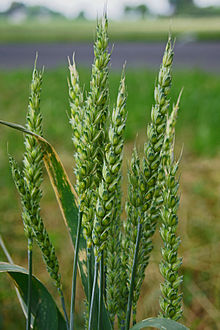Graminales
| Poales Temporal range: Late Cretaceous - Recent (but see text) 66–0 Ma |
|
|---|---|
 |
|
| Common wheat (Triticum aestivum) | |
| Scientific classification | |
| Kingdom: | Plantae |
| Clade: | Angiosperms |
| Clade: | Monocots |
| Clade: | Commelinids |
| Order: |
Poales Small |
| Families | |
|
See text |
|
See text
The Poales are a large order of flowering plants in the monocotyledons, and includes families of plants such as the grasses, bromeliads, and sedges. Sixteen plant families are currently recognized by botanists to be part of Poales.
The flowers are typically small, enclosed by bracts, and arranged in inflorescences (except in the genus Mayaca, with solitary terminal flowers). The flowers of many species are wind pollinated; the seeds usually contain starch.
The APG III system (2009) accepts the order within a monocot clade called commelinids, and accepts the following 16 families:
The earlier APG system (1998) adopted the same placement of the order, although it used the spelling "commelinoids". It did not include the Bromeliaceae and Mayaceae, but had the additional families Prioniaceae (now included in Thurniaceae), Sparganiaceae (now in Typhaceae), and Hydatellaceae (now transferred out of the monocots; recently discovered to be an 'early-diverging' lineage of flowering plants).
The morphology-based Cronquist system did not include an order named Poales, assigning these families to the orders Bromeliales, Cyperales, Hydatellales, Juncales, Restionales and Typhales.
In early systems, an order including the grass family did not go by the name Poales but by a descriptive botanical name such as Graminales in the Engler system (update of 1964) and in the Hutchinson system (first edition, first volume, 1926), Glumiflorae in the Wettstein system (last revised 1935) or Glumaceae in the Bentham & Hooker system (third volume, 1883).
...
Wikipedia
